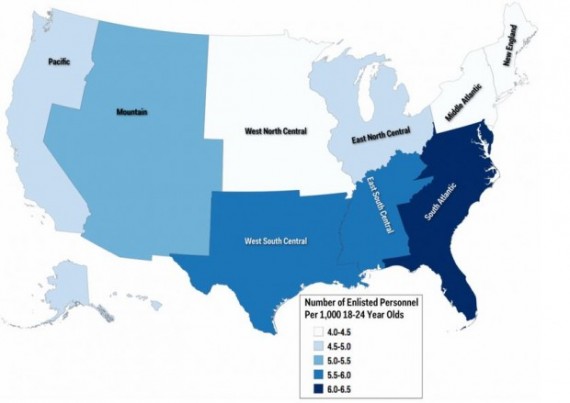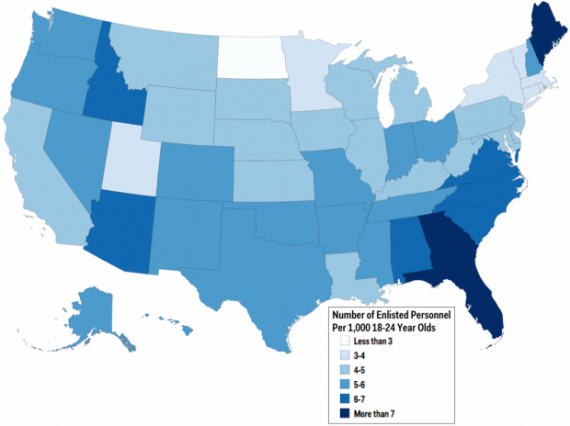Military Enlistment Rates by State and Region
The South and Southwest have a much higher military enlistment rate than the Northeast.
It likely won’t shock you that the South and Southwest have a much higher military enlistment rate than the Northeast:
Or that Georgia and Florida have among the highest rates of enlistment in the country—although maybe it would surprise you that Maine is right there with them:
Jeremy Bender, Andy Kiersz, and Armin Rosen, who compiled the maps for Business Insider using Defense Department data, offer some plausible explanations:
In 2013, 44% of all military recruits came from the South region of the U.S. despite it having only 36% of the country’s 18-24 year-old civilian population.
On the above map, some of the lowest rates of state-by-state enlistment are in New England and the Northeast, Maine notwithstanding. The Northeast of the U.S. was the most underrepresented region of the country for recruitment in 2013: Despite having 18% of the 18-24 year-old civilian population only 14% of new enlistments came from this area.
[…]
The Department of Defense does not have a good explanation for why some state’s are more proportionally represented than others. However DoD spokesman LCDR Nate Christensen hazarded a guess.
“One reason might be exposure to large military bases in states where there are higher enlistment rates,” Christensen told Business Insider.
Christensen’s explanation may explain why Florida or Georgia have such high enlistment numbers, as both states are home to a large number of Naval, Marine, Army, and Air Force bases. However, this explanation does not address why Maine has such a proportionally high number of enlistees.
Others reasons, which we hope to get to in future posts on military demographics, may be that cultural or economic differences make some groups more likely to join. There may also be differences in the approach to recruiting in different areas.
“A soldier’s demographic characteristics are of little importance in the military, which values honor, leadership, self-sacrifice, courage, and integrity-qualities that cannot be quantified,” Sheana Watkins and James Sherk cautioned in a 2008 Heritage Foundation study of the backgrounds of U.S. servicemembers. ”Demographic characteristics are a poor proxy for the quality of those who serve in the armed forces,” they continue, “but they can help to explain which Americans volunteer for military service and why.”
Aside from those explanations, the level of economic opportunity in an area obviously influences the propensity to enlist but there’s no really obvious pattern. Yes, Georgia, Florida, and Maine all have fairly high youth unemployment rates—all three hovered around 16% in 2012—but several states with substantially higher unemployment rates had substantially lower enlistment rates. For example, California had a staggering 34.6% rate in the 16-19 age category and 20.2% in the 16-24 category.







No doubt a large part of this is also cultural, as mentioned at the link.
Although I can’t quite figure out why Maine is the lone anomaly in the Northeast. And, it’s also kind of odd to see that a large part of the Upper Mid West goes along with the low enlistment rates of the Northeast.
Did you mean Georgia and Florida there, not Alabama and Florida?
@Doug Mataconis:
It’s the cold war. You need to to defend the east coast from Russian bombers. Where do you put most of your defenses?
HINT: http://en.wikipedia.org/wiki/Azimuthal_equidistant_projection
The youth unemployment rate sure works as an argument for North Dakota. I’m surprised that, judging by Utah’s number, the heavily conservative Mormons aren’t big on enlisting.
Maine’s been the poorest New England state historically, so perhaps there’s a longstanding tradition of joining the military as a way of getting a job and getting an education and some skills that might be useful in obtaining work in civilian life.
Also, it might be a way of getting out of isolation. Rural Maine can be one of the loneliest places in the world. As the late Bob Parker once observed, “The only place more rural would be the moon.”
@Doug Mataconis: “it’s also kind of odd to see that a large part of the Upper Mid West goes along with the low enlistment rates of the Northeast.”
That’s pretty easy. The Upper Mid West was settled by Northeasterners, with a smattering of “peace Church” Germans.
@Shane Street: Yes! Fixed. Alabama is in the next highest category.
Doing it by state is misleading, Here in Oregon the more southern and eastern parts of the state have been economically since before the great rescission. I’m sure this applies to other states as well.
@Mu:
Eighteen year old Mormon men do enlist at high rates — for their missions.
@Mu: A lot of Mormon youth in Utah go on a mission for the LDS church directly after graduating from high school. I would imagine it directly affects their military enlistment rates.
@Doug Mataconis:
Have you been to Maine, I mean the interior of Maine, not the coast? Think Appalachia North and you’ve got it. I don’t how folks get through the winters up there. They are long, cold, and hard. If there ever was a place for young people to get the hell out of, that’s it. And maybe Alaska.
Well, you’d need to filter those youth percentage numbers for the recent announcement that most youth were physically, academically, morally unfit or to tattooed for service.
@JKB:
Nope, I found this. There doesn’t seem to be any correlation.
Perhaps look at the hostility of the regional education system to being proud of America? If you are taught America is bad, you are unlikely to be willing to defend it.
Do you actually think there are wide swathes of public education out there teaching America is bad? Good lord. Teaching “America isn’t perfect” is not the same as “America is bad” (I’d say it’s more patriotic actually, since mindless nationalism is idiotic) and while I’m sure there are crappy teachers out there on the subject the idea that it’s widespread is just another silly trope from websites convinced “the libruls” are out to get them.
The military bases explanation is far more convincing. Look at my home, Washington state (gay marriage and legal weed–if anyone’s teaching that America is bad it must be here, right?). But we’ve got quite a lot of military in the region and very respectable enrollment rates (same general rate as Texas and the rest of the non-deep South).
I think there is a huge cultural component. I think the south has a long tradition of generational service and parents don’t discourage their children from joining.
In New England while people respect service there is a cultural trend to discourage serving. My daughter has a friend who wanted to join the army but her mother went into full attack mode and talked her out of it. This is pretty common. In the south where I grew up serving was encouraged or at least not discouraged. Around here serving is a choice of last resort.
@just me: The way my father put it was, “You can always join the army.” Never mind that I’m a total pacifistic wimp.
That and up until World War 1, my family had a bad history of being on the losing side of every war one of us fought in. Loyalists in the Revolution, Confederates in the Civil War, Americans in the War of 1812,
Mexicans in the Mexican-American War…Would love to see an overlay of educational achievement and economic opportunity for 18 year olds. My kids joined because they didn’t study in school and, frankly, other doors were closed. Military service (particularly for enlisted folks) is often a last-resort decision.
It’s a mixture of both patriotic perceptions (notice I didn’t say “patriotism” per se) and availability of other opportunities. My boyhood home in the Florida panhandle had a lot in common with places like the southern and western quadrants of Milwaukee and the central Ohio River valley (where I also lived). In such places, if you had the money, you went to college. Otherwise, you went out a got a job (even doing menial work) or you went into the military. The same was true in western Pennsylvania where my aunt is from. Also, with the exception of military kids and service academy graduates, military service-as-patriotic-expression has a large class component.
I bet there’s a cost-of-living component to this. An average military paycheck is going to be a lot more attractive to a kid just getting by in Alabama or Maine than it would to a kid just getting by in New York or California. It’s not a perfect fit, but it’s something.
I suspect that people from Georgia, Texas, Florida, and other darker states went back to those states after serving in the military. Thus the next generation was exposed to veterans. I also suspect that many veterans from Michigan, Ohio. Minnesota stayed in Texas, Florida, or California after serving in the military. Who is going back to Detroit after seeing San Diego.
Really, only dummies with no prospects in the military. Can anyone explain how that came about in the last 6 years compared to the conclusions from a 2008 Heritage report?
@JKB: The Heritage report is right so far as it goes. The US military doesn’t take anyone with a criminal record or who isn’t a high school graduate or in the top three quintiles of IQ—unless it gets very, very desperate. Compared to their age cohorts, those who enlist in the US armed forces are well above the national average.
That doesn’t mean, however, that the military isn’t a more attractive option for 18-year-olds in rural Georgia than 18-year-olds in New York City.
@James Joyner:
No doubt, but some here seemed to be channelling John Kerry.
But as was also mentioned, state/regional data isn’t very helpful. County level with filtering for metro areas would give more clues.
This would be interesting to hear more about.
@superdestroyer:
Oh man, you’re like a living breathing skit from Chappelle’s Show.
@James Pearce:
I was referring to darker on the map above. Gee.
@superdestroyer: Fair enough. I apologize for assuming it had a racial component. That was not very generous of me.
@JKB:
What does that mean?
@James Pearce:
Another thing I was thinking about on the map is that the veterans who went back home to Michigan may have had a less satisfactory experience in the military versus those who enlisted in Michigan but stayed in California, Texas, Florida. If someone growing up in Michigan is only around veterans who talk about how much they hated the military, it would have an effect on recruiting.
Oh, FFS, that first infographic in particular is misleading. The difference between white and the darkest blue is actually pretty small (could be as low as a 25% difference), much less than the massive difference in shade indicates.
The state one is a little more interesting.